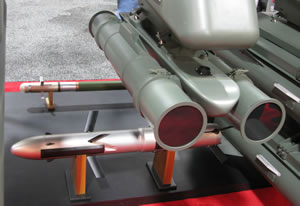
The U.S. Air Force awarded Raytheon the largest order yet for the Griffin missile,amounting over $85 million. The first delivery order will buy 22 all-up rounds and 43 telemetry rounds, to be delivered by July 2013. Previous orders of the Griffin were destined for the Special Operations Forces were awarded last year (2011) by the Army and U.S. Air Force.
These orders funded the procurement of 140 Block IIA and 25 telemetry rounds for about $30 million. Raytheon has been contracted annual firm-fixed-price orders for these weapons since 2008.
Griffin is 43 inches long, weighs 33 pounds and has a 13-pound warhead. Its range is believed to exceed the Hellfire’s 8 km range, reaching up to 12km when fired from high altitude. The Griffin uses loft maneuver and trajectory shaping to maximize range and achieve a steep angle of attack, thus maximizing hit accuracy while minimizing the risk of collateral damage or laser reflection errors.

The Griffin missile is in production and has already been integrated on the C-130 Harvest Hawk where it already was fired in anger in Afghanistan. Griffin A is an aft-eject missile designed for employment from non-conventional platforms such as the C-130 aircraft. Griffin B is a forward-firing missile that launches from rotary- and fixed-wing aircraft and ground-launch applications. (Each B model is contained in launch tube weighing 12 pounds. ) One of the platform considered as a carrier is the AT-6, the Griffin has also been fired from the OA-58D/F Kiowa Warrior helicopter. Other launching platforms already believed to be operational are the MQ-9 Reaper and MQ-1 Predator unmanned aircraft systems (UAS); the Navy also planned test firing the missile from an MQ_8B FireScout but that has not been confirmed yet. Surface platforms being tested include the Rolling Airframe Missile (RAM) launcher used on some of the US Navy vessels (such as the Littoral Combat Ship – LCS). The Griffin was also launched from simple surface mounted ‘wedge launcher’, to be used for the protection of forward operating base (FOB).
During a test performed earlier this year the Army tested the Griffin B missile demonstrating how such missiles could be used to secure FOBs and small combat outposts. During the test, warfigthers fired a Griffin missile from a launcher at a static target more than 4 kilometers (2.5 miles) away. Using GPS coordinates generated by a tethered aerostat, the missile directly impacted the target. In another demonstration carried out last year, a Griffin was fired from a land-based RAM launcher at a static target more than 3 kilometers (approximately 2 statute miles) away. The weapon, guided by GPS and laser, scored a direct hit on the target. Both tests achieved all demonstration objectives, Raytheon said.
“Griffin enables ground forces to protect their locations by precisely engaging targets in a 360-degree radius,” said Harry Schulte, vice president of Raytheon Missile Systems’ Air Warfare Systems product line. “Griffin enables sailors to defend against small, fast-moving surface craft employed by pirates and other non-traditional threats” Schulte added. The Griffin’s user-friendly graphic interface enables the user to guide the weapon to the target using GPS coordinates or laser designation. To maximize effectiveness, the user can choose to engage the target with height of burst, point detonation or fuze delay.

















